List of Authors
>>About this blog
Recent blog post
|
[Marsha Horiuchi of Edo]
June 19, 2015 09:00
This time, it is located at 4-chome Nihonbashi Muromachi, where I accidentally passed by.
"Nihonbashi Fukushimakan MIDETTE"
This is an announcement of the fossil excavation experience.
Now, Fukushima Prefecture has suffered various reputational damages, and the number of people going out for sightseeing seems to be drastically decreasing.
Therefore, the Boratia people are famous for producing a lot of fossils (ammonites, ).
It was appealing at MIDETTE.
At the back of the restaurant, you can feel free to excavate.
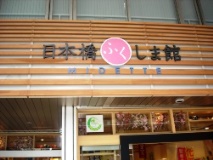 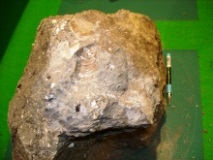
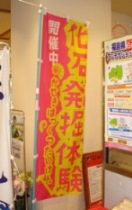 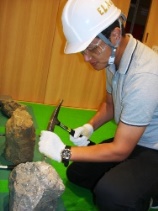
I guess it's not good for free study during school summer vacation, but I'm exclusively a hot spring.
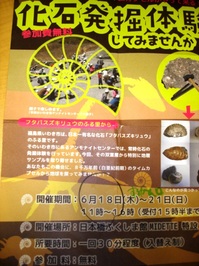 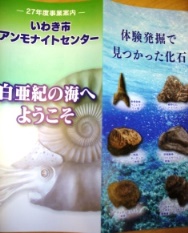
Sometimes it was a rainy season. Cool Biz will be available until the end of October.
Until the autumn wind blows without blurring with daily ingenuity.
[Dimini ☆ Cricket]
June 18, 2015 18:00
From June 15th, at "Gallery Ginza" in Ginza 2-chome, "The Color of Wind Light, Painting with Cut and Paste", Hiroho Tanabe Cutting Art Exhibition" is being held.
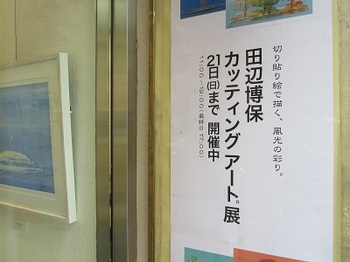
First of all, when I saw the works exhibited at the venue, I felt the clear beauty of the colors used, the soft texture of paper, and the wonderfulness of cutting.
Deeply convinced by the description of "cutting and pasting a new sensation"
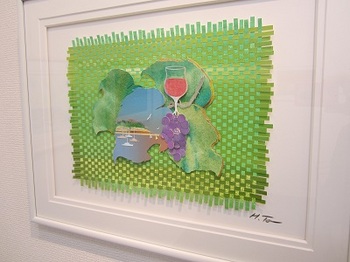
Cutting art is a painting in which a drawing is first created, the image is painted on a white paper, the color is selected, cut, and pasted, and the finish is a little three-dimensional. It seems that it is characterized by the appearance (3D sense).
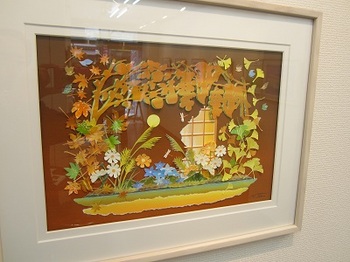
All of the works make you feel the natural light, and each work has a sense of air, and it makes you feel relieved to see it. The three-dimensional effect that is pasted gives depth to the work, the plants sway in the wind, and waves rush on the beach, and the world of the work is drawn into the world of the work.
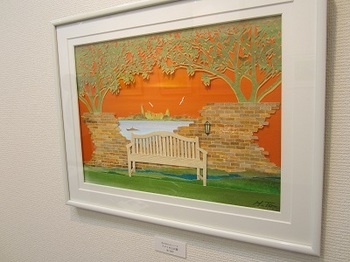
By the way, it was named "cutting art" by Dr. Tanabe, and it is also registered as a trademark.
The teacher also teaches "cutting art" with lectures in Nagano, Yokohama, Tama Plaza, etc.
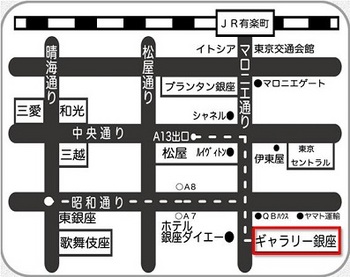
The cutting art exhibition will be held from 11:00 to 19:00. The last day is the 21st (Sun) and the last day is until 17:00 . .
In fact, if you see the work at the venue, you will be able to feel the wonderfulness.
In addition, with your consent, we took a picture of the venue. Thank you very much for your cooperation.
Click here for the website of "Hiroho Tanabe Cutting Art Exhibition" ⇒
http://www.cart-tanabe.com/
     
[Marsha Horiuchi of Edo]
June 18, 2015 14:00
The word "Shigatefu" often appears in historical novels and city history pamphlets.
Speaking of now, it would be per 1-chome Muromachi, but the origin of the name was curious.
Recently, I found an explanation on the first floor of a corner building across the east intersection of Nihonbashi Kitazume.
I'm finally refreshed. (1st floor of the black building in the photo below)
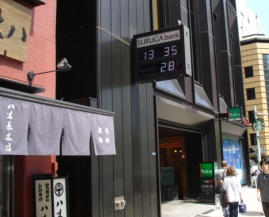
It's written in that explanation.
There used to be a corner called Surugacho in Nihonbashi. When Ieyasu Tokugawa opened the Shogunate in Edo.
Surugacho was the land given for the townspeople who followed the country of Suruga.
At that time, it was reported that there were reeds all over here.
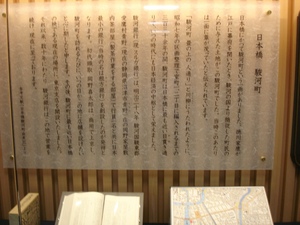 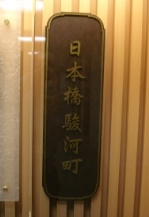
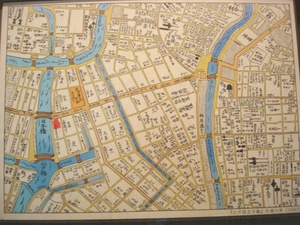
Nihonbashi in Edo, located in Hiroshige's "Hundred Famous Views of Edo", looks like the shutters of Yutodo in the neighborhood of Muromachi.
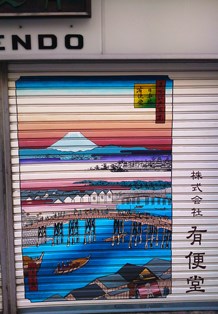
Nihonbashi, where no expressways are built
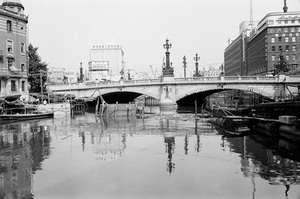
Nihonbashi, where highways are built, and giboshi, at the departure and departure point of Nihonbashi South Packing.
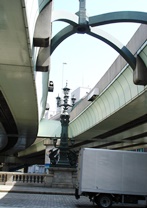 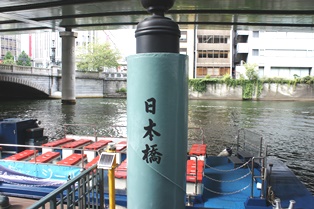
Restore Nihonbashi in the 19th century on the 3rd floor of the departure lobby from Haneda Airport!
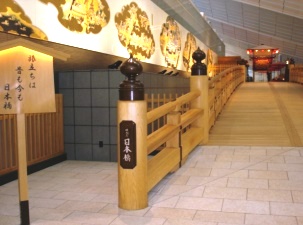 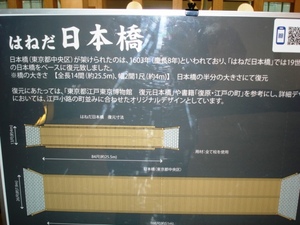
Photo above Chuo-ku in 1944 (in front of Mitsukoshi Station)≫
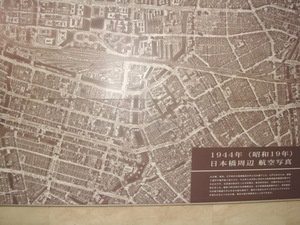
Cool Biz is until the end of October, making you wonder why a tie is needed.
It's an early heat these days. Until the autumn wind blows without blurring with daily ingenuity.
1.
June 18, 2015 09:00
June 16th is "Japanese Confectionery Day". Many people may have seen the entrance of the confectionery shop. "Kasho" was the basis of this "Japanese sweets day". Regarding the origin, Emperor Nimei offered confections based on the 16th number based on the oracle in the late Heian period and changed to Kasho to remove the plague, and then in the Muromachi period, `` Gadding 16 sentences of Jiading Toho and bowed. " During the Edo period, it became an annual event and was one of the climbing days, and it was said that confectionery was distributed to various daimyo and flagships at Edo Castle great hall. According to the Toto Tojiki, "Kaisho's celebration, the castle of various princes. It is said that this is a great place. It is said, "It follows the Imperial Palace ritual that eats sweets offered to God as an exorcism." By the way, "Kading Treasure" was imported from Soong when Zen coins were not yet made in Japan in Song Qian. It says, "20,000 sweets are lined up in the Edo Castle large hall" (Toraya's website), so it is somewhat fun just to imagine that the daimyo and Hagimoto dressed in front of it will receive sweets from the general beautifully. It is said that the common people also had a tradition of eating sweets and rice cakes in 16 sentences as "Kasho-ku". It seems that it was established as "a happy event to escape the plague and wish for health."
As you know, Mr. Taneya is the head office in Omihachiman City, and since it entered Tokyo in 1984 (1984), it has been more than 30 years. It's completely blended into Tokyo. I've booked that Taneya is making "Kichicho Yoshisho", a limited release of "Kasho" only one day. It's my first time, so I'm excited. It's just the day of tea lessons, so I wanted to show it to my friends and asked for twofolds. It's 800 yen for 6 pieces per turn. We wrapped Koshian in dumpling dough and treated Domyoji Temple (explanation of the shop). It was very popular with my friends.
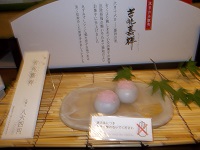 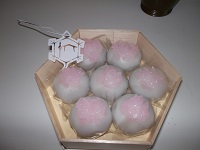
Taneya makes many kinds of seasonal sweets, but some of them are fashionable creative Japanese sweets such as "Olive Daifuku" and "Agar Tomato". At the end of June, "Mizunazuki", which is related to "Summer Exorcism", will be released only for two days on June 29th and 30th. Please enjoy Japanese sweets that make you feel the season with your eyes and tongue.
Taneya Ginza Mitsukoshi Store TEL3535-9640
[CAM]
June 17, 2015 18:00
The elementary and junior high schools I attended were located in the east and west of the Daimaru Department Store in Shinsaibashi, Chuo Ward, Osaka, across Midosuji. Therefore, for me, "Daimaru" is a representative of department stores, and after the war, the opening of the Tokyo store at Yaesu Exit of Tokyo Station was the "(first) advance" to "Tokyo". I was thinking.
However, in Shigure Hasegawa's "Old Mon Nihonbashi", "There is a noun called Daimaru at the starting point of the most common city. This was just the point of Nihonbashi culture and prosperity at that time, just as pointing to Mitsukoshi kimono shop now, but it was a famous kimono shop of Odozo-zukuri that had risen resolutely in Yotsutsutsuji along Daimon-dori, on the corner opposite Toyu-cho. At one point, the name of the location of Daidenmacho 4-chome Daimaru kimono store was renamed Torikango-cho, and a faithful Gonsuke who had been working for Daimaru for many years was sinned by rewriting the town tag as the importance of the main family. The store was a symbol of the town so much that there was a turmoil. "
Looking at the "History of Daimaru" on the current "Daimaru Matsuzakaya Department Stores" website, it is as follows.
|
1717
|
<1717> Hikoemon Shimomura Masahira opened a kimono shop "Camonjiya" in Fushimi, Kyoto. (founded Daimaru)
|
|
1726
|
<1726> Opened the Osaka store "Matsuya" in Shinsaibashisuji, Osaka, and began selling cash bills.
(Current location of Shinsaibashi store)
|
|
1743
|
<1743> Edo store opened in 3-chome, Nihonbashi Daidenmacho, Edo.
|
|
1910
|
<1910> The Edo and Nagoya stores were closed.
|
|
1954
|
<1954> The Tokyo store opened at Yaesu Exit of Tokyo Station.
|
The Saiden Stecker "Tokyo Shitamachi Yamanote (LOW CITY, HIGH CITY)" (translated by Tetsuo Anzai) states as follows.
(Road) The influence of trains was even greater. It is a typical example of this, such as Daimaru of a kimono shop. Among the current department stores, it is not uncommon to have developed from a former kimono shop, but Daimaru was one of them, opening in Nihonbashi in the 18th century, and in the middle of the Meiji era it was more prosperous than Mitsukoshi. As Shigure Hasegawa wrote, Daimaru said, "It was the center point of Nihonbashi culture and prosperity at that time, just as it refers to the Mitsukoshi kimono store." However, unlike other stores, Daimaru did not face the train street leading from Ginza to Ueno. Therefore, customers gradually moved away, and at the end of the Meiji era, they had to knock down a store in Tokyo and withdraw to Kansai. I returned to Tokyo after World War II, but this time I set up a store in the station building of Tokyo Station to prevent it from being out of transportation. (73)
[Dimini ☆ Cricket]
June 17, 2015 14:00
On the first floor of Nihonbashi Plaza Building in Nihonbashi 2-chome, there is an antenna shop in Yamanashi Prefecture called Fujinokuni Yamanashikan.
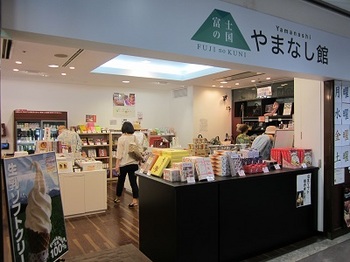
While the specialty products unique to Yamanashi are lined up, "abalone boiled shellfish" is displayed in the best position in front of the entrance as a special product of the prefecture without the sea, and it became " ". ".
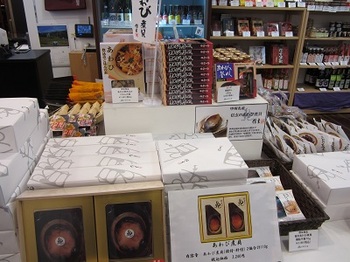
When I heard, "abalone boiled shellfish" has long been a specialty of Koshu () and is just ashamed of my unknown. and is just ashamed of my unknown.
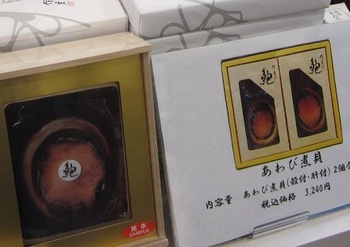
For a long time, the people of Koshu, surrounded by mountains on all sides, want to manage the seafood (it's reasonable!) On the way home, a Koshu merchant who went to Numazu, Suruga Bay (Shizuoka Prefecture) simmered the landed abalone on the beach, pickled it in a soy sauce barrel, put it on the back of a horse, and swaying over Gotemba-Subashiri-Kagosaka Pass While the abalone fluttered, the soy sauce was moderately adapted and softly aged to the delicious "c shellfish" was made.
It is said that Kai's warlord, Prince Takeda Shingen of Furin Volcano, recognized the value high and used it for nutritional support and hospitality for guests.
As a specialty of Koshu, it was a venerable and historical one.
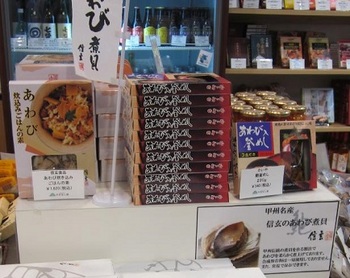
In addition, we received prior consent  regarding photography in the store. Thank you for your cooperation m(__)m regarding photography in the store. Thank you for your cooperation m(__)m
Click here for the website of Fuji no Kuni Yamanashikan. ⇒
http://www.yamanashi-kankou.jp/tokyo/index.html
  
|
Links
|



















